How Much Does It Cost to Install Solar Panels?
The average cost to install solar panels ranges from $21,000 to $42,000 for a typical residential system with a capacity of 5 kW to 10 kW. This translates to approximately $3.50 to $6.30 per watt. The total cost of installation can vary depending on several factors, including the size of the system, the type of solar panels, the complexity of the installation, and any additional components required. For instance, larger systems not only generate more electricity but also benefit from economies of scale, potentially lowering the cost per watt. Thus, it is crucial to weigh your current and future energy needs when deciding on system size.
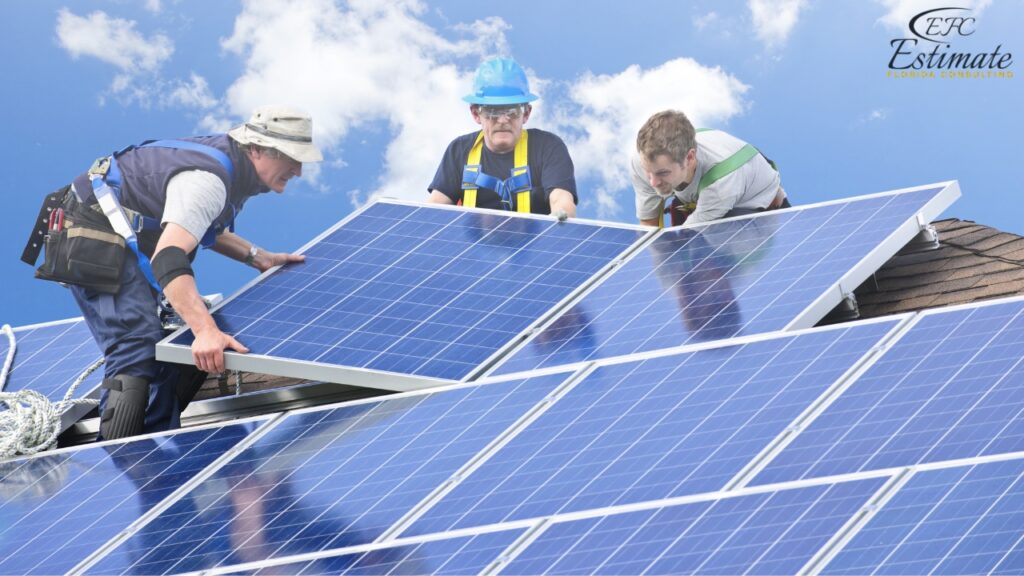
System Size | Cost per Watt | Total Cost Range |
5 kW System | $4.55 – $8.19 | $22,750 – $50,250 |
7 kW System | $4.55 – $8.19 | $31,750 – $57,400 |
10 kW System | $4.55 – $8.19 | $45,500 – $81,000 |
Factors Influencing Solar Panel Installation Costs
Several factors can impact the overall cost of installing solar panels. Understanding these factors will help you budget accurately and make informed decisions about your solar energy system, leading to a more efficient investment.
System Size
The size of the solar panel system you choose will directly affect the cost. Larger systems with higher capacity will generally cost more, but they can also provide more energy savings and benefits. The capacity needed will depend on your energy consumption and the amount of sunlight your location receives. A larger system may be more cost-effective in the long run if it meets a significant portion of your energy needs. For example, if your household uses a substantial amount of electricity due to appliances, heating, or air conditioning, investing in a larger solar system may lead to substantial savings on energy bills. Consider your energy usage patterns and consult with a solar professional to determine the optimal system size for your home.
System Size | Estimated Annual Energy Output (kWh) | Estimated Cost Savings per Year |
5 kW System | 6,000 – 8,000 | $840 – $1,120 |
7 kW System | 8,400 – 11,200 | $1,176 – $1,568 |
10 kW System | 12,000 – 15,000 | $1,680 – $2,100 |
Type of Solar Panels
The type and quality of solar panels you select can impact the overall cost. There are different types of solar panels, including monocrystalline, polycrystalline, and thin-film, each with varying efficiencies and price points. Monocrystalline panels, for example, are typically more expensive but offer higher efficiency and a longer lifespan compared to polycrystalline or thin-film panels. Investing in higher-quality panels may provide better performance and durability, potentially leading to greater long-term savings. When evaluating panel options, consider not just the upfront cost, but also the expected performance, warranty, and manufacturer reputation. Understanding the differences in panel technology can help you make a more informed decision that aligns with your energy goals and budget.
Panel Type | Efficiency (%) | Average Cost per Watt | Lifespan (Years) |
Monocrystalline | 15 – 22 | $4.20 – $7.00 | 25+ |
Polycrystalline | 13 – 16 | $3.50 – $5.60 | 25 |
Thin-Film | 10 – 13 | $2.10 – $4.20 | 20 – 25 |
90% More Chances to Win Projects With Our Estimate!
- Multi-Family Building
- Hotel Building
- Hospital Building
- Warehouse Building
- School & University Building
- High-Rise Building
- Shopping Complex
- Data Center Building
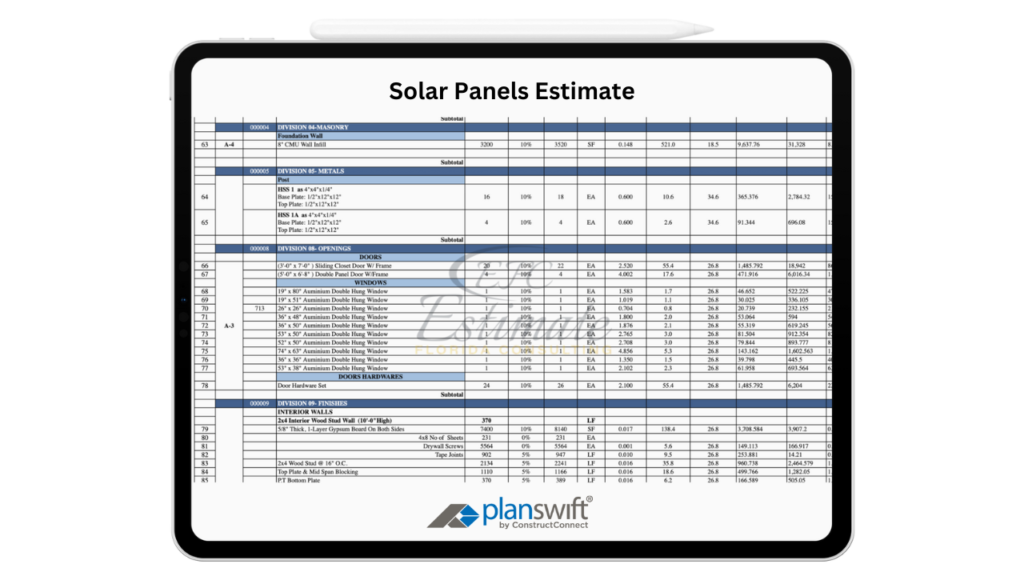
Installation Complexity
The complexity of the installation can also affect the overall cost. Factors such as the condition of your roof, the type of mounting system required, and any necessary electrical upgrades will influence the cost. For example, a roof with a steep pitch, multiple obstacles, or aging materials may require roof restoration before solar panels can be safely installed, increasing the installation costs. Additionally, if your home requires structural modifications or upgrades to accommodate the solar system, these factors will add to the overall expense. It’s essential to assess the specifics of your property and work with a professional installer to address any potential challenges. Before installation begins, thorough inspections and assessments should be performed to determine if any underlying issues, such as roof damage, need to be addressed, which can further impact the budget and timeline.
Installation Factor | Impact on Cost | Additional Considerations |
Roof Condition | +10% – +30% | Repair or replacement may be needed |
Mounting System Type | +5% – +15% | Ballasted, flush mount, or ground mount |
Electrical Upgrades | +5% – +20% | Upgrading the panel or wiring may be required |
Additional Components
Beyond the solar panels themselves, additional components such as inverters, mounting systems, and batteries can impact the total cost. Inverters convert the solar energy generated into usable electricity for your home, and their cost can vary based on the type and capacity needed. Battery storage systems, while optional, can add to the cost but provide the benefit of storing excess energy for use during non-sunny periods. A well-designed system that includes these components can enhance the overall efficiency and reliability of your solar power setup.
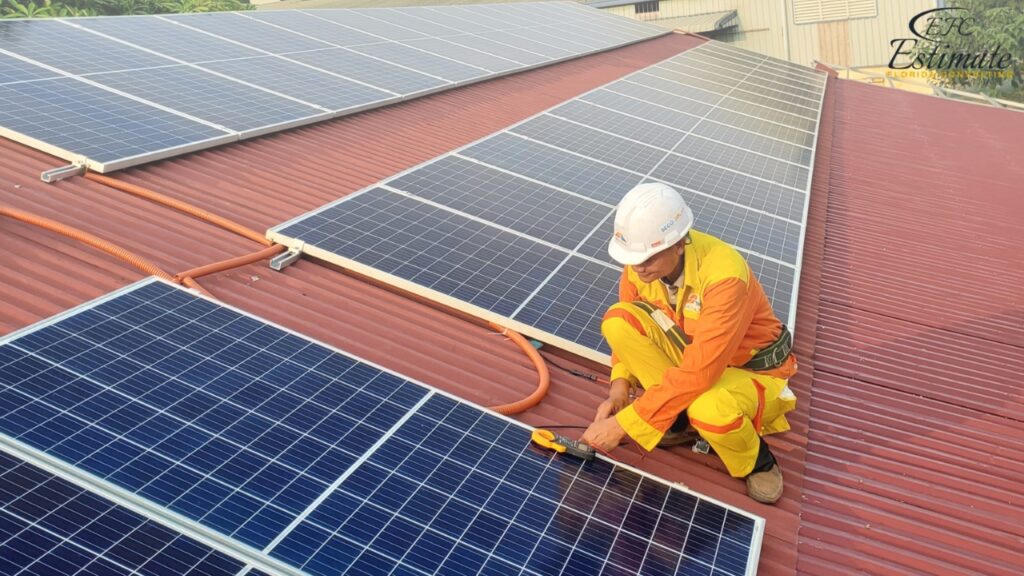
Homeowners should evaluate their energy needs to determine whether a battery system would be a worthwhile investment, especially in areas prone to power outages or where electricity rates fluctuate significantly.
Component | Average Cost | Function |
Inverter | $1,400 – $4,200 | Converts DC to AC power |
Battery Storage System | $7,000 – $14,000 | Stores excess energy for later use |
Mounting System | $700 – $3,500 | Supports the solar panels on the roof or ground |
Financing Options
Several financing options are available for solar panel installations, making it more accessible for homeowners to invest in solar energy. These financing methods can help lower upfront costs and facilitate your transition to renewable energy.
Solar Loans
Solar loans allow homeowners to finance the cost of solar panel installations over a fixed period, typically ranging from 5 to 20 years. These loans often come with competitive interest rates and flexible repayment terms. Solar loans can help spread the cost of installation into manageable monthly payments, making it easier to budget for your solar investment. Additionally, some lenders offer programs specifically designed for solar financing, which may have more favorable terms compared to traditional loans. It’s advisable to shop around and compare different loan offers to find the best financing solution for your solar project.
Loan Type | Interest Rate | Loan Term | Monthly Payment Example (for $35,000) |
Secured Solar Loan | 4% – 8% | 10 years | $400 – $650 |
Unsecured Solar Loan | 6% – 12% | 5 years | $700 – $900 |
Solar Leases
Solar leases allow homeowners to lease solar panels from a provider for a fixed monthly payment. In this arrangement, the provider typically handles the installation, maintenance, and operation of the solar system. Solar leases can offer the benefit of lower upfront costs and no maintenance responsibilities, but they may not provide the same long-term savings as owning the system outright. It’s important to understand the terms of the lease, including how it affects your home’s resale value and whether there are options to buy the system after the lease period ends. Additionally, consider any potential escalations in lease payments over time and how that might affect your long-term financial planning.
Lease Term | Monthly Payment Range | Maintenance Responsibility |
20 years | $140 – $280 | Provider |
25 years | $210 – $350 | Provider |
Power Purchase Agreements (PPAs)
Power Purchase Agreements (PPAs) involve purchasing the electricity generated by the solar panels rather than the panels themselves. Under a PPA, a third-party provider installs and maintains the solar system, and you agree to buy the electricity at a fixed rate. This can provide cost savings compared to traditional utility rates and eliminate upfront costs. PPAs can be particularly attractive for homeowners who prefer not to make a large initial investment and want to enjoy the benefits of solar energy without the burden of system ownership. Always review the terms carefully to ensure there are no hidden costs or penalties that could affect your budget.
PPA Rate | Average Cost per kWh | Savings Potential |
Fixed Rate | $0.11 – $0.21 | 10% – 30% compared to local utility rates |
Incentives and Rebates
Various incentives and rebates are available to reduce the upfront cost of installing solar panels. These can significantly impact the overall cost and improve the return on investment for your solar system, making solar energy more accessible to homeowners.
Federal Tax Credit
The federal solar tax credit, also known as the Investment Tax Credit (ITC), allows homeowners to deduct a percentage of the cost of installing a solar energy system from their federal taxes. As of 2023, the tax credit is set at 30% of the total installation cost, providing a substantial financial incentive for homeowners to invest in solar. For a $35,000 solar system, for instance, you could potentially receive a tax credit of $10,500, making the overall cost of the system significantly lower after applying this benefit. It’s important to consult with a tax professional to understand how this credit applies to your situation and to ensure you meet all eligibility requirements.
Installation Cost | Tax Credit (30%) | Final Cost After Credit |
$35,000 | $10,500 | $24,500 |
$50,000 | $15,000 | $35,000 |
Download Template For Solar Panels Project Breakdown
- Materials list updated to the zip code
- Fast delivery
- Data base of general contractors and sub-contractors
- Local estimators
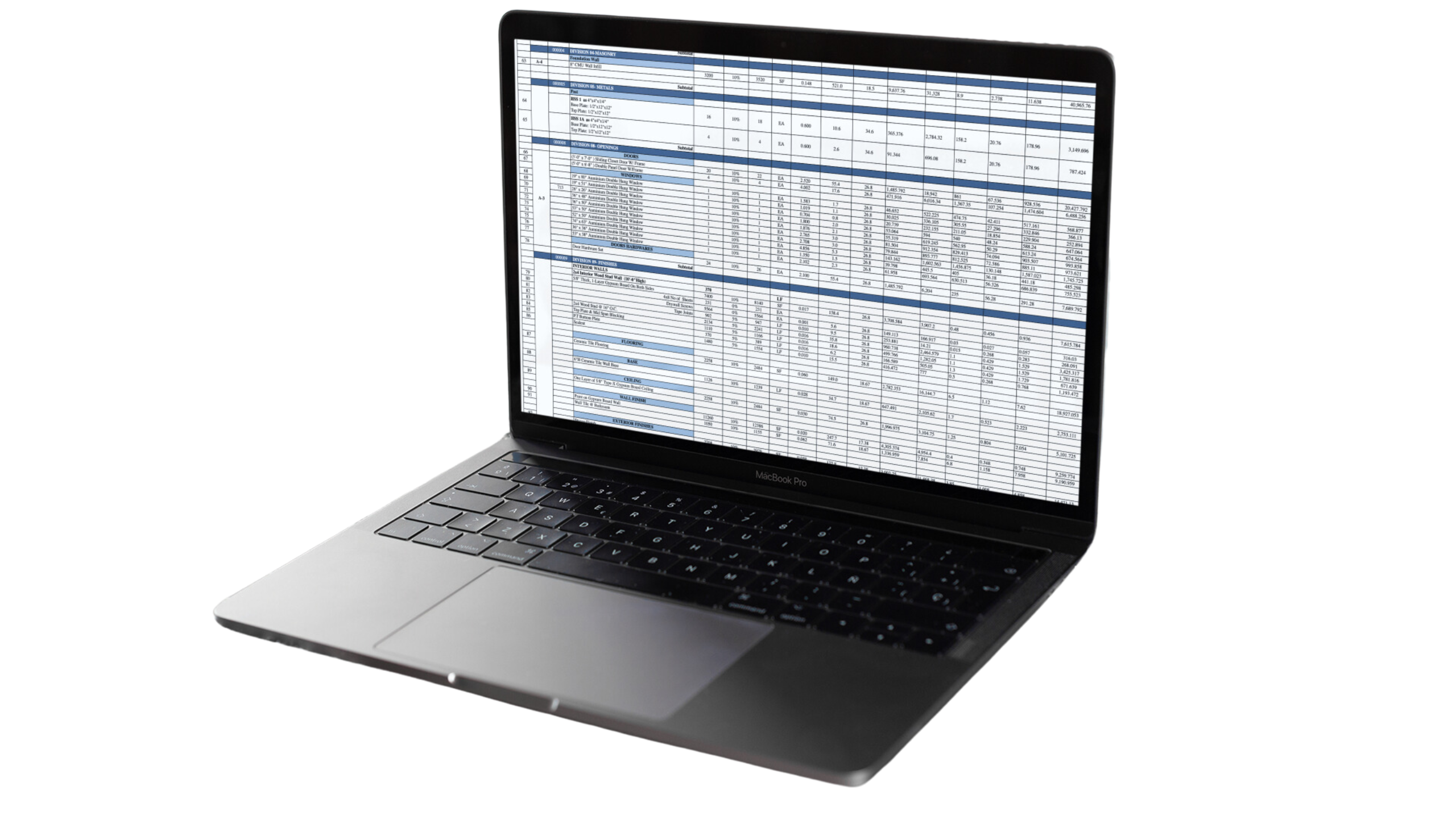
Conclusion
Investing in solar panels is a substantial financial commitment, but it can yield significant long-term benefits, including reduced energy costs and increased property value. By understanding the costs associated with solar panel installation, including the various factors that influence pricing and available financing options, homeowners can make informed decisions that align with their financial goals and energy needs. The transition to solar energy not only supports individual savings but also contributes to a cleaner, more sustainable future. If you’re considering making the switch to solar, consult with a reputable solar provider to get a personalized estimate tailored to your home’s unique circumstances.
FAQs
The average return on investment (ROI) for solar panels varies based on several factors, including the initial cost, available incentives, and local electricity rates. Homeowners can typically expect a payback period of 5 to 10 years, with long-term savings of up to $30,000 or more over the lifespan of the system.
Most solar panels come with warranties of 25 years, but many panels can continue to operate effectively for 30 years or more. Over time, the efficiency of solar panels may decline slightly, but they can still provide substantial energy savings throughout their lifespan.
For many homeowners, investing in solar panels is worth it due to the potential savings on electricity bills, increased property value, and environmental benefits. Conducting a thorough cost-benefit analysis based on individual energy needs and local incentives can help determine if solar is the right choice for your situation.
Google Reviews

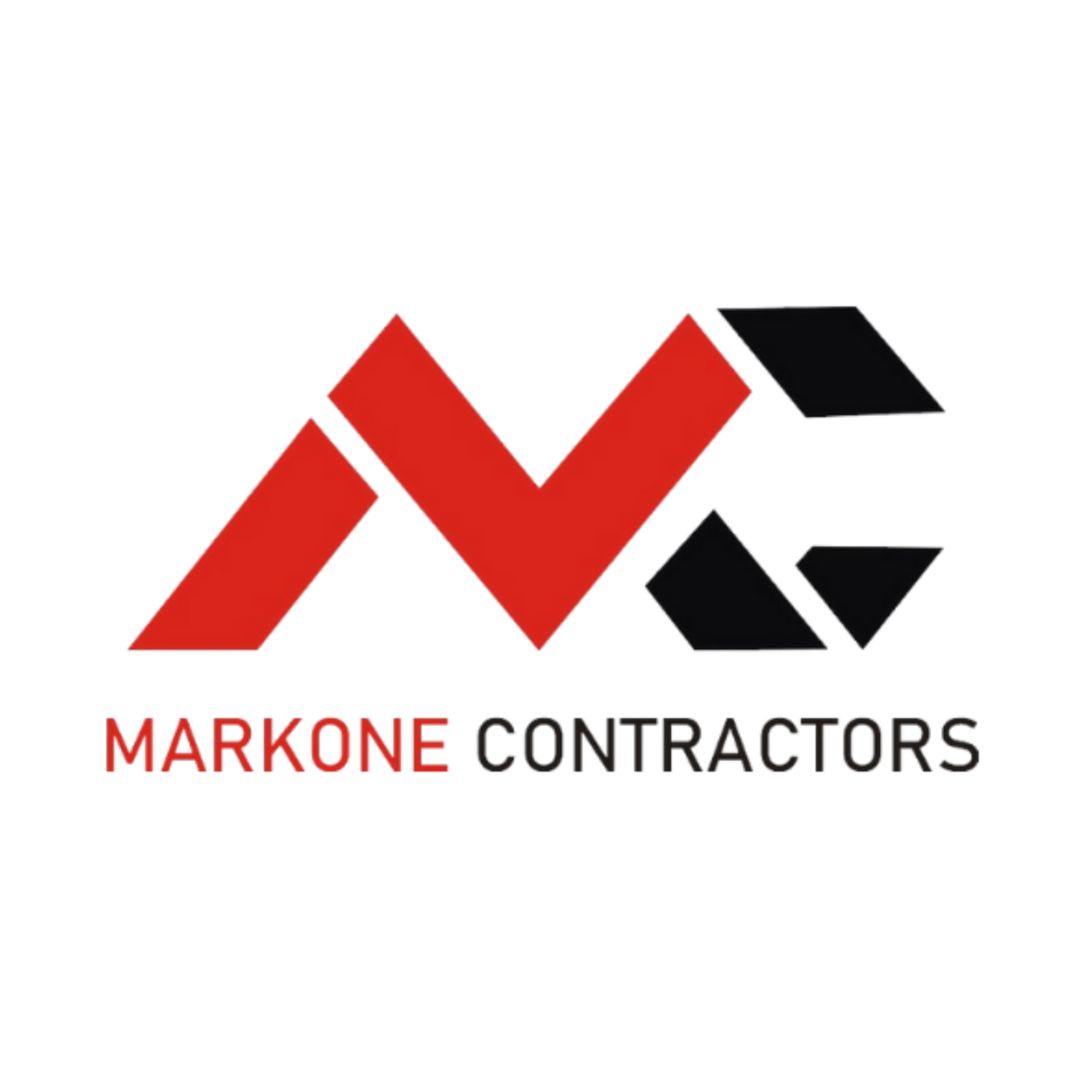

Process To Get It Cost to Install Solar Panels Estimate Report
Here I am going to share some steps to get it cost to install solar panels estimate report.
-
You need to send your plan to us.
You can send us your plan on info@estimatorflorida.com
-
You receive a quote for your project.
Before starting your project, we send you a quote for your service. That quote will have detailed information about your project. Here you will get information about the size, difficulty, complexity and bid date when determining pricing.
-
Get Estimate Report
Our team will takeoff and estimate your project. When we deliver you’ll receive a PDF and an Excel file of your estimate. We can also offer construction lead generation services for the jobs you’d like to pursue further.

